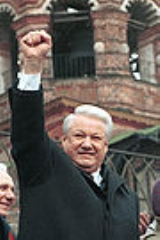
1990 The Russian parliament elects Boris Yeltsin president of the Russian SFSR.
1991 Russians elect Boris Yeltsin as the president of the republic.
1992 Boris Yeltsin announces that Russia will stop targeting United States cities with nuclear weapons.
1992 A 'joint understanding' agreement on arms reduction is signed by U.S. President George H. W. Bush and Russian President Boris Yeltsin (this would be later codified in START II).
1993 In Moscow, George H. W. Bush and Boris Yeltsin sign the second Strategic Arms Reduction Treaty (START).
1993 Russian President Boris Yeltsin suspends parliament and scraps the then-functioning constitution, thus triggering the Russian constitutional crisis of 1993.
1993 Russian Constitutional Crisis: In Moscow, tanks bombard the White House, a government building that housed the Russian parliament, while demonstrators against President Boris Yeltsin rally outside.
1994 First Chechen War: Russian President Boris Yeltsin orders Russian troops into Chechnya.
1996 First Chechnya War: Russian President Boris Yeltsin meets with Chechnyan rebels for the first time and negotiates a cease-fire.
1999 Russian President Boris Yeltsin fires his Prime Minister, Sergei Stepashin, and for the fourth time fires his entire cabinet.
1999 Boris Yeltsin, the first president of Russia, resigns as President of Russia, leaving Prime Minister Vladimir Putin as the acting President.
2007 Boris Yeltsin's funeral – the first to be sanctioned by the Russian Orthodox Church for a head of state since the funeral of Emperor Alexander III in 1894.

